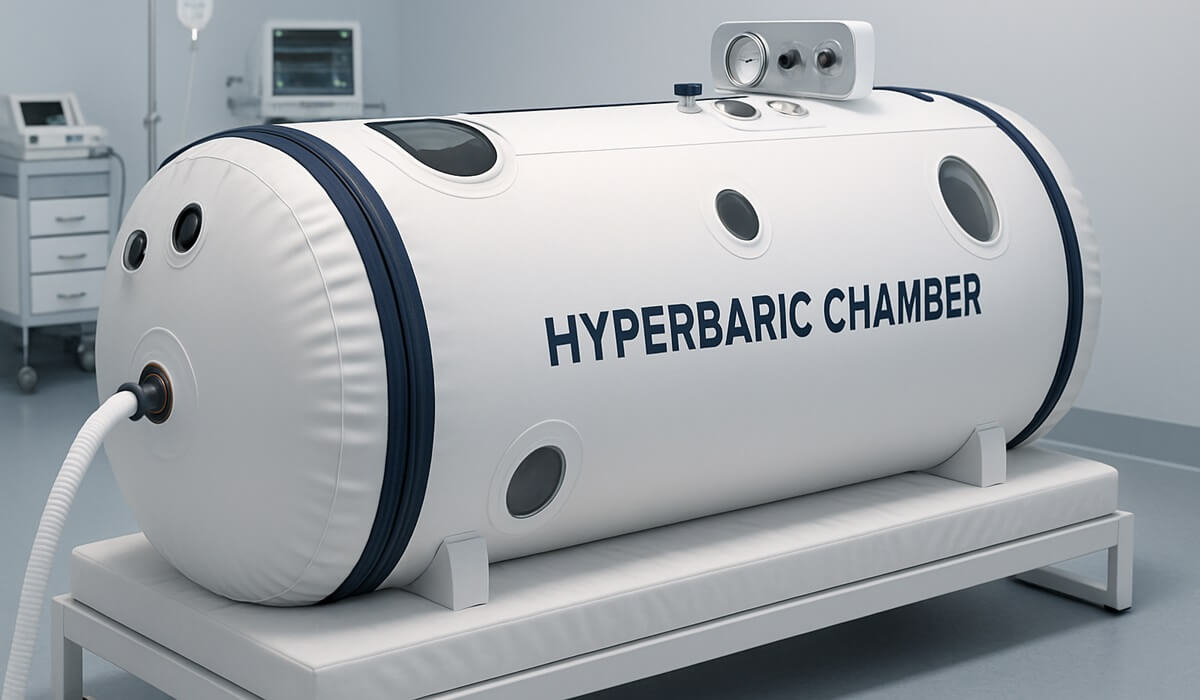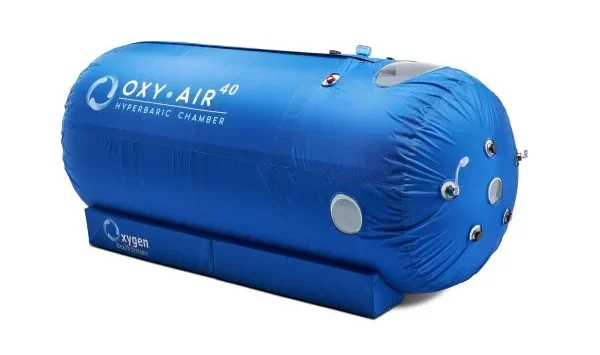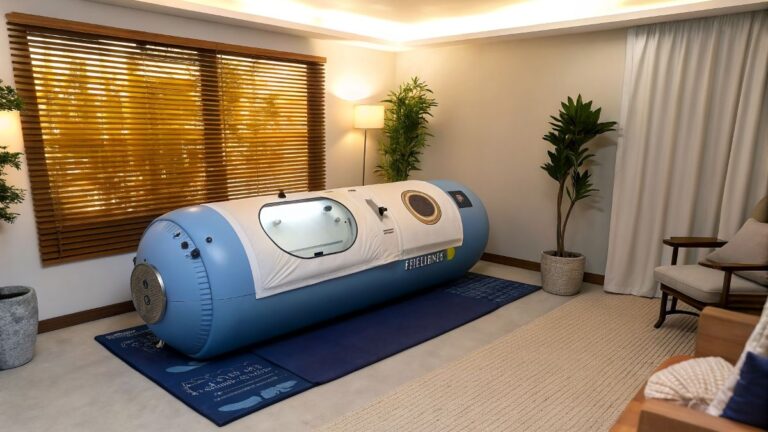I’ve spent months researching soft shell hyperbaric chambers, and honestly? The home HBOT market has exploded.
What used to be a niche wellness treatment reserved for clinics is now sitting in people’s living rooms. These inflatable chambers promise the benefits of mild hyperbaric oxygen therapy (mHBOT) without the hefty price tag or space requirements of traditional hard shell units.
Soft shell hyperbaric chambers are blowing up right now. The hyperbaric oxygen therapy market was valued at $34.5 billion in 2023 and is projected to grow at a CAGR of 6.51% through 2032, with portable hyperbaric chambers alone expected to reach $628.55 billion by 2032 at an 8.50% growth rate. [1]
But what exactly are we talking about here?
Soft shell hyperbaric chambers are inflatable units that deliver mild hyperbaric oxygen therapy (mHBOT) = pressurized oxygen treatment at lower pressures than medical-grade hard chambers. These puppies typically operate between 1.3 to 1.5 ATA (atmospheres absolute), which is roughly 30-50% more pressure than you’d experience at sea level.
The whole point? Getting more oxygen into your bloodstream to potentially speed up healing, reduce inflammation, and boost recovery.
Athletes use HBOT to speed up recovery from strenuous training or injuries, while wellness enthusiasts are exploring its potential for improving brain function and cellular regeneration. [2]
Here’s the deal though – I’m not here to tell you what miracles these chambers can or can’t perform. That’s between you and your doctor. What I can tell you is which soft shell chambers are actually worth your hard-earned cash if you’re thinking about jumping into the home HBOT game.
Important disclaimer: This review is for informational purposes only and doesn’t constitute medical advice. Always consult with a healthcare professional before using hyperbaric oxygen therapy, especially if you have any underlying health conditions.
Why Choose a Soft Shell Hyperbaric Chamber? (Pros & Cons)
Let me break down what you’re getting into with soft shell chambers versus their hard shell cousins.
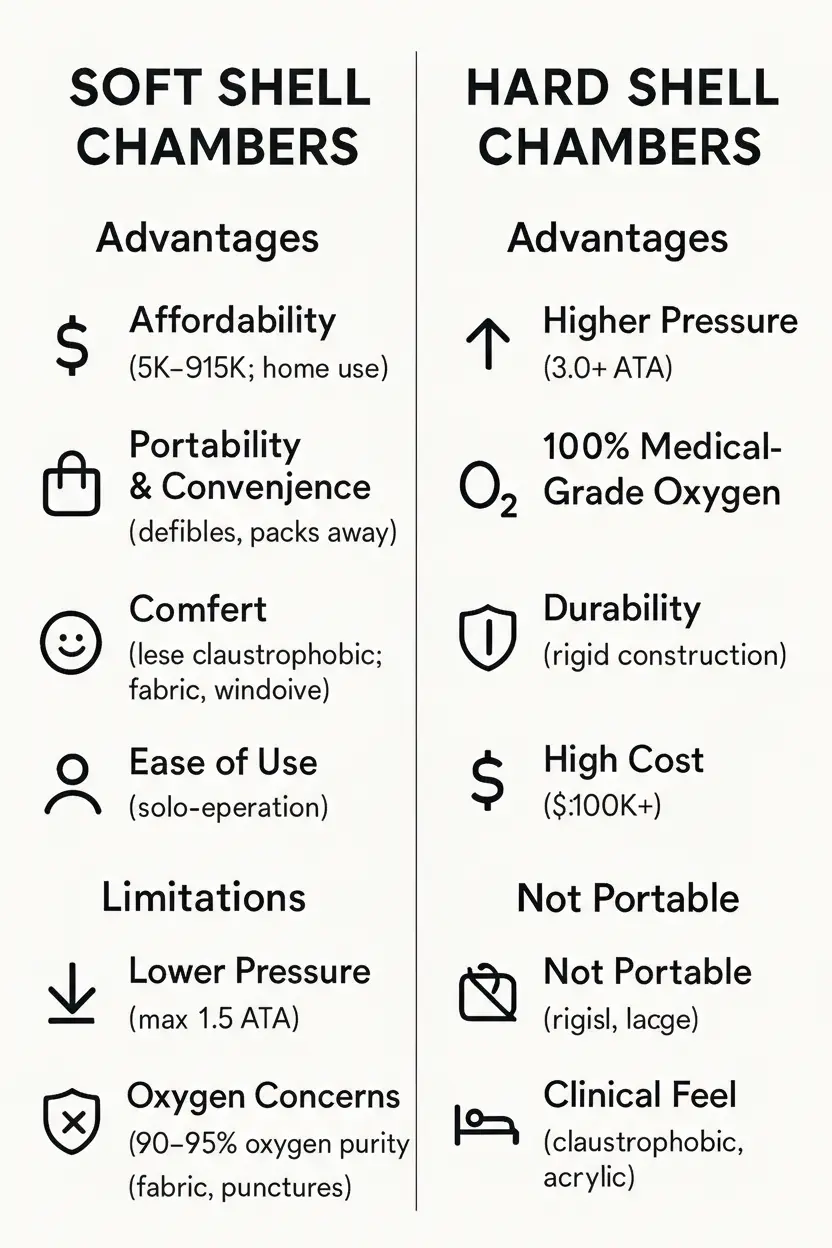
✅ Advantages of Soft Shell Chambers
- Affordability: Hard shell chambers can run you $100K+. Most soft shells fall between $5K-$15K = way more accessible for home use.
- Portability & Convenience: These things deflate and pack away like a giant air mattress. You can literally store one in a closet when you’re not using it. Try doing that with a rigid acrylic chamber that looks like a medical submarine.
- Comfort: Many users find soft shells less claustrophobic than hard chambers. The fabric walls feel less clinical, and you’ve got viewing windows to keep you connected to the outside world.
- Ease of Use: Most soft shell systems are designed for solo operation. No need for a technician or assistant – just zip yourself in and hit the power button.
🤔 Limitations of Soft Shell Chambers
- Lower pressure limitations represent the biggest trade-off. Soft chambers max out around 1.5 ATA, while hard chambers can safely reach 3.0+ ATA. For certain medical conditions requiring higher pressures, soft shells simply won’t cut it. [3]
- Oxygen delivery differences matter more than most people realize. Soft chambers typically use oxygen concentrators to achieve 90-95% oxygen purity, not the 100% medical-grade oxygen found in hard chambers. This impacts the therapeutic dose you’re actually receiving.
- Durability concerns with fabric materials versus rigid acrylic or steel construction. While modern soft chambers use NASA-grade materials, they’re still more vulnerable to punctures, wear, and potential failure over heavy long-term use.
How We Picked the Best Soft Shell Hyperbaric Chambers
I didn’t just pick these chambers out of thin air. Here’s exactly what I looked for:
The Best Soft Shell Hyperbaric Chambers of 2025
| Chamber Model | Best For | Price | Pressure | Key Advantages |
|---|---|---|---|---|
| LUX AIR 36-Inch | Overall Best | $14,749 | 1.4 ATA |
• Highest pressure (33% more) • J-style door for solo use • Premium NASA materials • 3-year warranty |
| OXY-AIR 40-Inch | Spacious Design | $10,990 | 1.3 ATA |
• Largest diameter (40″) • ISO certified • Perfect for tall users • Clinical quality |
| Summit to Sea Shallow Dive | Portability | $6,995 | 1.3 ATA |
• Most portable • Redundant compressors • Translucent design • Best under $7K |
| OxyMa | Best Value | $6,729 | 1.3-1.4 ATA |
• Lowest price • Pressure options • Perfect for beginners • Compact design |
| Summit to Sea Dive Vertical | Sitting Chamber | $9,000-$12,000 | 1.3 ATA |
• Vertical sitting design • 38″ diameter base • Ideal for mobility issues • Read during sessions |
Quick Guide:
Green badge (1.4 ATA) = Higher therapeutic pressure
Orange badge (1.3 ATA) = Standard therapeutic pressure
Blue badge (1.3-1.4 ATA) = Flexible pressure options
1. LUX AIR 36-Inch Soft Hyperbaric Oxygen Chamber – Best Overall
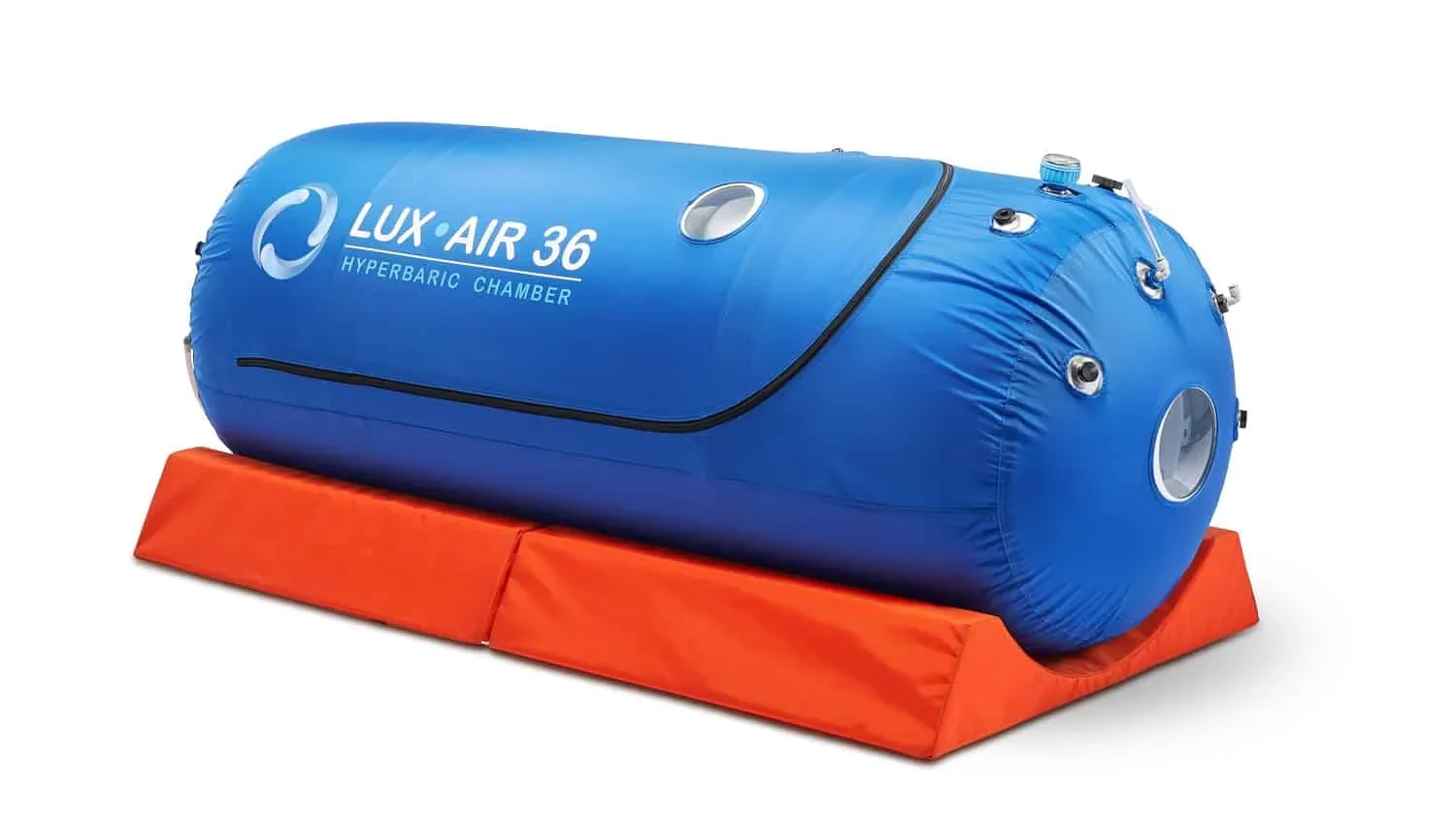
This is my top pick for good reason. This chamber earned top marks for delivering the most complete package at a reasonable price point. Hyperbaric PRO designed the LUX AIR with their signature J-style door system, which honestly makes entry and exit easier than any other chamber I’ve reseaerched. Plus, the LUX AIR delivers 33% more pressure than standard 1.3 ATA chambers, which could make a meaningful difference in therapeutic benefits.
Price: $14,749
Manufacturer: Hyperbaric PRO
Pressure: 1.4 ATA
Key Specifications:
- 36-inch diameter, 89-inch length
- Medical-grade 3-layer PET Polyester/TPU with Dacron technology
- J-style door design for easy solo entry/exit
- 2-person weight capacity
What Sets It Apart: The J-shape door is brilliant – you can get in and out without assistance, unlike chambers with traditional zippered entries. The 16-inch elevation platform is included, plus you get a 10 LPM FDA-approved DeVilbiss oxygen concentrator and dehumidifier (normally a $700 add-on).
✅ Pros:
- Higher pressure than most competitors (1.4 vs 1.3 ATA)
- Innovative door design for independent use
- Premium NASA-trusted materials
- Excellent component package with quality concentrator
- Silent pressure relief valves eliminate annoying hissing
- 3-year warranty
🤔 Cons:
- Premium pricing puts it above many budgets
- Larger footprint requires more space
- Overkill if you just want basic mHBOT
➡️ Best For: Serious users who want maximum pressure and convenience features, don’t mind paying extra for quality engineering.
Here’s a very useful video that demonstrates the chamber.
Available online through Hyperbaric PRO with 3-year warranty and ISO certifications
2. OXY-AIR 40-Inch Hyperbaric Oxygen Chamber – Best Spacious Design
Oxygen Health Systems created the largest soft chamber available with their 40-inch diameter design. If you’re tall, broad, or just don’t like feeling cramped, this is your chamber. The 40-inch diameter is among the largest available in soft shells.
Price: $12,990
Manufacturer: Oxygen Health Systems
Pressure: 1.3 ATA
Key Specifications:
- 40-inch diameter (one of the largest available)
- Medical-grade materials with durable construction
- Standard 1.3 ATA pressure
- ISO certifications (14001, 13485, 9001)
✅ Pros:
- Spacious interior for comfort
- Solid build quality and certifications
- Reasonable price for the size
- Suitable for clinical and home use
- ISO certified manufacturing
🤔 Cons:
- Only 1.3 ATA pressure (lower than LUX AIR)
- Limited details on specific components included
- Larger chambers need more space and airflow
➡️ Best For: Larger individuals or anyone who prioritizes interior space over maximum pressure.
🛒Price: $12,990 through Oxygen Health Systems online store
3. Summit to Sea Shallow Dive – Best for Portability
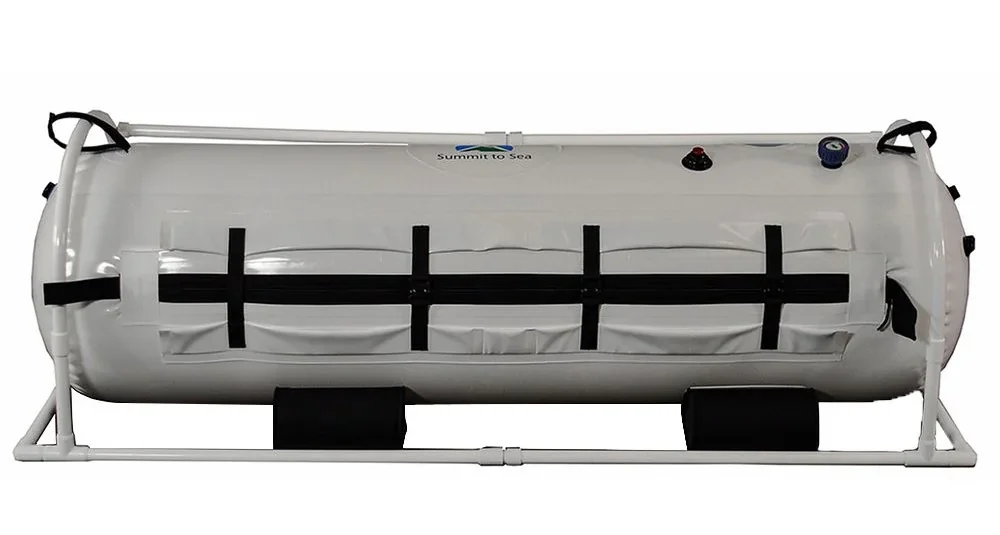
This is the most portable option on our list. If you need something you can actually travel with or store easily, the Shallow Dive delivers. I was impressed by how quickly this system sets up and breaks down for transport or storage.
Price: $6,995
Manufacturer: Summit to Sea
Pressure: 1.3 ATA
Key Specifications:
- 26-inch diameter, 84-inch length
- Single-bag urethane-coated nylon shell
- Lightweight and portable design
- Redundant compressors for safety
Unique Features: The translucent material lets room light diffuse in, reducing the cave-like feeling. You get two compressors for redundancy, plus a comprehensive accessory package including cleaning supplies and setup instructions on a thumb drive.
✅ Pros:
- Most portable and lightweight option
- Redundant compressors for safety
- Comprehensive accessory package included
- Translucent walls reduce claustrophobia
- Good value at under $7K
- Patented sound suppression technology
🤔 Cons:
- Smaller 26-inch diameter limits comfort for larger users
- Single-bag design may be less durable long-term
- Basic feature set compared to premium options
➡️ Best For: Users who prioritize portability, travel frequently, or have limited storage space.
🛒 Price: $6,995 through Health Products For You
4. OxyMa Hyperbaric Chamber – Best Value
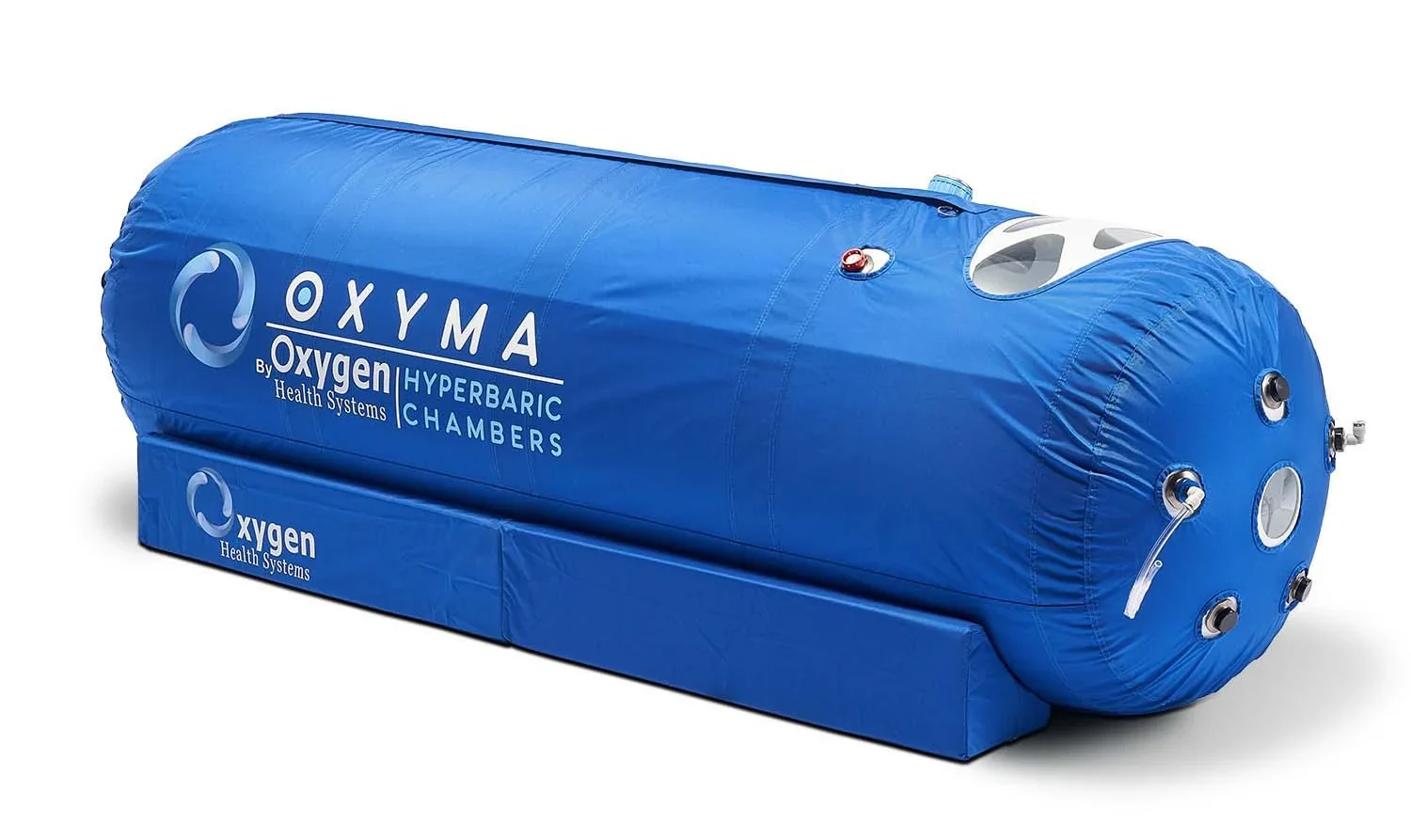
Oxygen Health Systems hit the sweet spot with their OxyMa model. You get solid construction, reliable safety features, and effective therapy at a price that won’t require a second mortgage.
Price: $8,600
Manufacturer: Oxygen Health Systems
Pressure: Available in 1.3 ATA and 1.4 ATA options
Key Specifications:
- 28-inch diameter
- Available in both 1.3 and 1.4 ATA versions
- High-quality medical-grade materials
- Compact yet comfortable design
- Applications: Sports recovery, wound healing, general wellness
✅ Pros:
- Excellent price-to-feature ratio
- Pressure options allow customization to needs
- Solid safety features included
- Good for beginners to HBOT
- ISO certifications for quality assurance
- Compact design fits most home spaces
🤔 Cons:
- Smaller diameter than premium options
- Fewer luxury features than higher-end chambers
- Basic component package
➡️ Best For: First-time buyers or budget-conscious users who want reliable mHBOT therapy without premium pricing.
🛒 Price: $8,600 through Oxygen Health Systems‘ secure online store
5. Summit to Sea Dive Vertical – Best Sitting Chamber
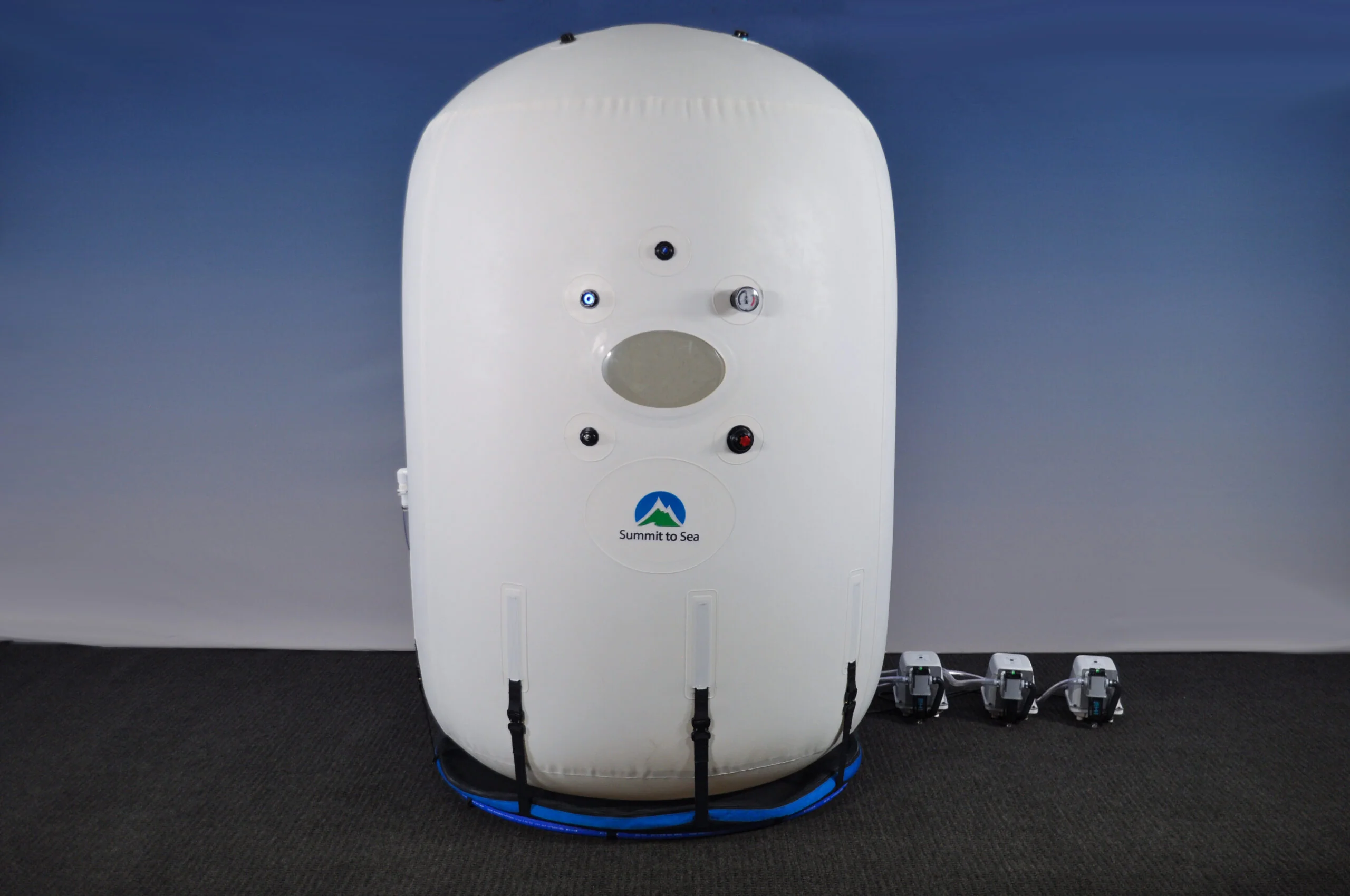
Some people just can’t or don’t want to lie down for 60-90 minutes. This vertical chamber solves this problem. The vertical design lets you sit comfortably during sessions.
Price: $9,000-$12,000 range
Manufacturer: Summit to Sea
Pressure: 1.3 ATA
Key Specifications:
- 38-inch diameter base
- Vertical design for sitting position
- Vertical zipper entry for easy access
- Durable medical-grade materials
✅ Pros:
- Comfortable sitting position
- Easy vertical entry/exit
- Good for reading or light activities during sessions
- Spacious feeling despite smaller footprint
🤔 Cons:
- Higher price than horizontal alternatives
- Limited availability (through dealers only)
- May not fit very tall users comfortably
➡️ Best For: Users who prefer sitting, with claustrophobia, mobility limitations, or who want to remain productive during therapy sessions.
🛒 Price: $9,000-$12,000 through authorized dealers
Key Features to Consider When Buying
ATA Pressure
Understanding pressure specifications prevents disappointment later. 1.3 ATA = 4.3 PSI above atmospheric pressure, while 1.4 ATA = 5.9 PSI, and 1.5 ATA = 7.4 PSI. These differences seem small but research suggests even modest pressure increases can enhance therapeutic benefits Frontiers in Neurology.
“But does higher pressure really matter in soft chambers?” The answer depends on your goals. For general wellness and recovery, 1.3 ATA provides measurable benefits. For enhanced cognitive function or more intensive recovery protocols, 1.4-1.5 ATA may offer advantages.
Size and Dimensions
Internal versus external dimensions trip up many buyers. A chamber with 36-inch external diameter might only provide 32-33 inches of usable internal space due to material thickness and internal frame structures.
Lying vs Sitting: Horizontal chambers work for most people and typically offer more length. Vertical chambers are better if you have trouble lying flat or want to read during sessions.
User height calculations require adding 6-8 inches to your height for comfortable positioning. If you’re 6 feet tall, look for chambers with 78+ inch internal length.
Material Construction Quality
- Heat-welded seams versus glued construction makes the difference between years of reliable service and premature failure. Heat welding creates molecular bonds in TPU materials that are significantly stronger than adhesive connections.
- Medical-Grade TPU: This is the gold standard. Look for 2-3 layer construction for durability and leak prevention.
- Seam Construction: Heat-welded seams beat glued seams every time. They’re stronger and less likely to fail over time.
- Zipper Quality: You want airtight, pressure-sealed zippers, preferably with dual-sided access (inside and outside pulls) for safety.
Essential Component Assessment
- Air compressor noise levels impact your experience significantly. Manufacturers claiming “quiet” operation should specify actual decibel ratings. Anything over 65 dB becomes annoying during longer sessions.
- Oxygen concentrator flow rates determine therapy effectiveness. 5 LPM minimum for basic benefit, 8-10 LPM for optimal therapy in most chambers. Don’t assume higher numbers are always better – match flow rate to chamber volume.
- Internal frame systems prevent chamber collapse before full inflation and maintain shape during use. Lightweight aluminum or fiberglass frames work best – avoid chambers without frames entirely.
- Air Cooler/Dehumidifier: Essential for comfort during longer sessions. You’ll get hot and humid inside without proper climate control.
Safety Feature Verification
- Pressure relief valve redundancy can save your life. Look for chambers with both automatic (factory-set) and manual (user-controlled) pressure relief systems. Single-valve designs create unnecessary risk.
- Emergency exit procedures should be simple enough to execute under stress. Practice emergency procedures when you first receive your chamber – don’t wait for an actual emergency to figure it out.
- Pressure gauge accuracy affects both safety and therapy effectiveness. Quality chambers include both internal and external gauges that are easy to read and properly calibrated.
- Viewing Windows: Multiple large windows reduce claustrophobia and allow external monitoring. Clear, non-toxic TPU construction is important.
- Monitoring Equipment: Internal and external pressure gauges let you track performance. Some units include power failure alarms.
Noise Level
This is often overlooked but crucial for home use. Compressors and oxygen concentrators can be loud. Look for decibel ratings – anything under 55 dB is considered quiet.
Who Can Benefit Most from Soft Shell Hyperbaric Chambers?
Athletes use HBOT to speed up recovery from strenuous training or injuries, while others explore its potential for improving brain function, especially after concussions or traumatic brain injuries. The FDA has approved HBOT for specific medical conditions, but soft shell chambers are often used for general wellness purposes.
Common users include:
- Athletes seeking faster recovery represent the largest user group I encounter. Research shows mHBOT can reduce inflammation and accelerate tissue repair, making it valuable for both endurance and strength athletes PMC.
- Wellness enthusiasts looking for general health optimization find soft chambers particularly appealing. The convenience of home therapy supports consistent use patterns that clinical visits often can’t match.
- Individuals with chronic fatigue or inflammatory conditions may benefit from the anti-inflammatory effects of mHBOT. A 2024 study demonstrated reduced oxidative stress and improved energy levels in chronic fatigue patients Universal Neuro Care.
- Busy professionals appreciate the ability to multitask during sessions (particularly in sitting chambers) while still receiving therapeutic benefits.
Frequently Asked Questions
Bottom Line
Soft shell hyperbaric chambers represent a legitimate way to access mHBOT benefits without clinical facility costs or scheduling constraints. The technology has matured significantly, with modern chambers offering genuine therapeutic benefits backed by growing research evidence.
My top recommendation remains the LUX AIR 36-Inch for users who can afford the premium price – its combination of higher pressure, superior construction, and comprehensive features justifies the investment. For budget-conscious buyers, the OxyMa chamber delivers solid therapy at an accessible price point.
The key is matching features to your specific needs. Athletes might prioritize higher pressure and faster recovery protocols. Wellness enthusiasts might prefer comfort features and ease of use. Portable users should focus on the Summit to Sea options despite their size limitations.
Most importantly: consult with a healthcare provider before beginning any hyperbaric therapy regimen. While mHBOT has an excellent safety profile, individual health conditions can create contraindications or require modified protocols.
What questions do you still have about soft shell chambers? Have you had experience with any of these models? I’d love to hear your thoughts and experiences in the comments below.
Sources and references cited throughout this article include peer-reviewed research from scientific journals, manufacturer specifications, and regulatory guidance from organizations like the FDA and UHMS. Always verify current regulations and consult healthcare providers for medical advice.
